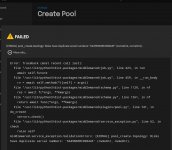Jayskie
Cadet
- Joined
- Mar 10, 2022
- Messages
- 8
Heya!
Had a weird issue that I can't seem to find my way around, I'm a complete noob at all of this, so forgive me if it's something easy.
I've tried adding my HDD as a strip pool and I get this error:
*Text version*
[EINVAL] pool_create.topology: Disks have duplicate serial numbers: 'S649NX0RC00844F' (nvme0n1, nvme0n1).
remove_circle_outlineMore info...
Error: Traceback (most recent call last): File "/usr/lib/python3/dist-packages/middlewared/job.py", line 423, in run await self.future File "/usr/lib/python3/dist-packages/middlewared/job.py", line 459, in __run_body rv = await self.method(*([self] + args)) File "/usr/lib/python3/dist-packages/middlewared/schema.py", line 1129, in nf res = await f(*args, **kwargs) File "/usr/lib/python3/dist-packages/middlewared/schema.py", line 1261, in nf return await func(*args, **kwargs) File "/usr/lib/python3/dist-packages/middlewared/plugins/pool.py", line 741, in do_create verrors.check() File "/usr/lib/python3/dist-packages/middlewared/service_exception.py", line 62, in check raise self middlewared.service_exception.ValidationErrors: [EINVAL] pool_create.topology: Disks have duplicate serial numbers: 'S649NX0RC00844F' (nvme0n1, nvme0n1).
I've tried formatting the HDD and u. It sure why it's trying to join nvme0n1 because it's a HDD and not an Nvme.
I'm using TrueNAS Scale.
Hope I've provided enough information, TIA!
Had a weird issue that I can't seem to find my way around, I'm a complete noob at all of this, so forgive me if it's something easy.
I've tried adding my HDD as a strip pool and I get this error:
*Text version*
[EINVAL] pool_create.topology: Disks have duplicate serial numbers: 'S649NX0RC00844F' (nvme0n1, nvme0n1).
remove_circle_outlineMore info...
Error: Traceback (most recent call last): File "/usr/lib/python3/dist-packages/middlewared/job.py", line 423, in run await self.future File "/usr/lib/python3/dist-packages/middlewared/job.py", line 459, in __run_body rv = await self.method(*([self] + args)) File "/usr/lib/python3/dist-packages/middlewared/schema.py", line 1129, in nf res = await f(*args, **kwargs) File "/usr/lib/python3/dist-packages/middlewared/schema.py", line 1261, in nf return await func(*args, **kwargs) File "/usr/lib/python3/dist-packages/middlewared/plugins/pool.py", line 741, in do_create verrors.check() File "/usr/lib/python3/dist-packages/middlewared/service_exception.py", line 62, in check raise self middlewared.service_exception.ValidationErrors: [EINVAL] pool_create.topology: Disks have duplicate serial numbers: 'S649NX0RC00844F' (nvme0n1, nvme0n1).
I've tried formatting the HDD and u. It sure why it's trying to join nvme0n1 because it's a HDD and not an Nvme.
I'm using TrueNAS Scale.
Hope I've provided enough information, TIA!

